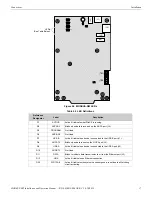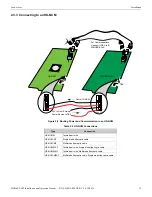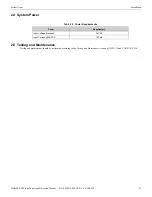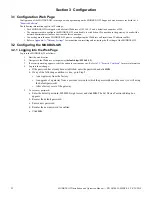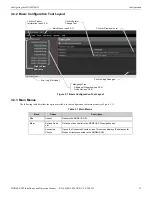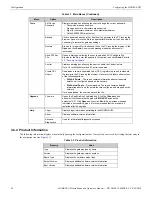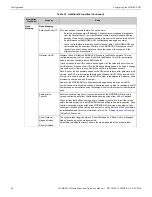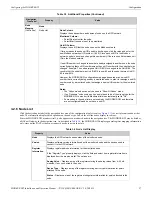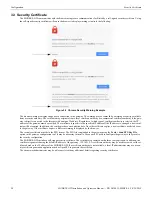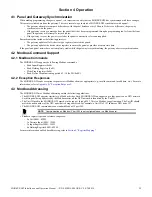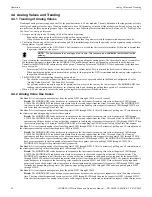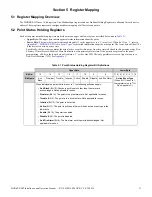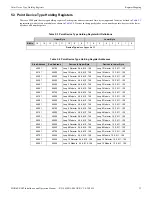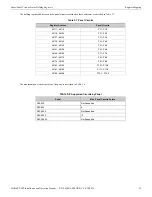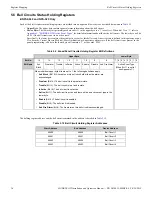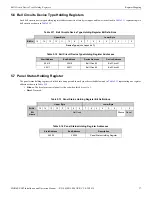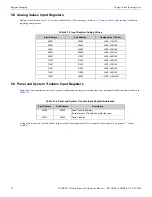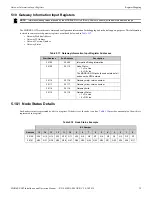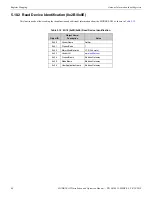
30
MODBUS-GW Installation and Operation Manual —
P/N LS10015-000NF-E:C2 4/30/2019
Operation
Analog Values and Trending
4.4 Analog Values and Trending
4.4.1 Trending of Analog Values
Trending of analog values is supported on all of the panels/networks 4–20 mA modules. The only limitation is that the gateway will only
actively read analog values for up to 10 analog modules at a time. All the analog values on all the modules can be read as long as a sepa-
rate poll is sent for these points in groups of up to 10 points at a time, following the rules outlined below. Reference 4.4.2, "Analog Value
Use Cases" for clarity on this issue.
• Accept a poll for up to any 10 analog (4–20 mA) points per gateway.
– Requests for more points than this are rejected with an exception code.
– If any of the points in the request are not 4–20 mA modules then the gateway rejects the request with an exception code.
• The first poll for analog values is an initialization poll. This initialization poll informs the gateway to start acquiring analog values for
these points at 5 second intervals.
– Points are only polled on the NFN if the 4–20 mA module is in at least the first level of alarm status. If the point is normal then
the gateway returns a value of zero.
• Upon receiving the initialization confirmation, the client can begin polling the analog points. The client should wait 5 seconds after
the initialization request to insure that the MODBUS-GW has had enough time to get the analog values and load the registers.
Thereafter the MODBUS-GW continues to poll the points. The analog value in the MODBUS-GW are updated no faster than once
every 5 seconds.
– Points are polled if the device is in at least the first level of alarm status. Zero is returned for devices not in alarm status.
– When a point being polled enters normal status, polling for that point on the NFN is terminated and the analog value register for
that point is filled with zeros.
• The MODBUS-GW ceases polling the analog points when:
– The client does not make a request for these exact same points over a period defined in the Modbus Configuration Tool as
“Analog Value Time Out”. The default is 20 seconds.
– The gateway makes a request for a point (or points) that is not
exactly the same as the initial request
. The MODBUS-GW first
sends an initial confirmation for the new set of analog points, and then begins polling those points at 5 second intervals.
• When a 4–20 mA module is in fault, the analog value register for that point is filled with zeros.
4.4.2 Analog Value Use Cases
Use Case 1:
A client requests analog values from the points L1M1 through L1M10 every 10 seconds.
Result:
The MODBUS-GW sends back zeros in response to the first request for analog values from the points L1M1 through
L1M10. The MODBUS-GW sends back actual values on the second request from the client 5 seconds later. The MODBUS-GW
continues to poll these devices as long as the client continues to send analog value requests for points L1M1 through L1M10 at a
rate faster than the Analog Value Time Out.
Use Case 2:
A client requests analog values from the points L1M1 through L1M10. After 10 minutes of polling on a 10 second interval,
the client stops requesting analog values for these points.
Result:
The MODBUS-GW sends back zeros in response to the first request for analog values from the points L1M1 through
L1M10. The MODBUS-GW sends back actual values on the second request from the client 10 seconds later. The MODBUS-GW
continues to poll these devices as long as the client continues to send analog value requests for points L1M1 through L1M10. When
the client stops polling at 10 minutes, the MODBUS-GW will stop polling the NFN after the Analog Value Time Out expire
s.
Use Case 3:
A client requests analog values from the points L1M1 through L1M10. After 10 minutes of polling on a 10 second interval,
the client requests analog values from the points L1M20 to L1M22.
Result:
The MODBUS-GW sends back zeros in response to the first request for analog values from the points L1M1 through
L1M10. The MODBUS-GW sends back actual values on the second request from the client 10 seconds later. The Gateway
continues to poll these devices as long as the client continues to send analog value requests for the points L1M1 through L1M10.
When the client sends a request for analog values from the points L1M20 through L1M22, the MODBUS-GW immediately sends
back zeros in response to the first analog value request from these points and starts polling L1M20 through L1M22. The
MODBUS-GW only polls the points specifically requested.
Use Case 4:
A client requests analog values from the points L1M1 through L1M10. After 10 minutes of polling on a 10 second interval,
the client requests analog values from the points L1M5 through L1M12.
Result:
The MODBUS-GW sends back zeros in response to the first request for analog values from the points L1M1 through
L1M10. The MODBUS-GW sends back actual values in response to the second request from the client 10 seconds later. The
MODBUS-GW continues to poll these devices as long as the client continues to send analog value requests for the points L1M1
through L1M10. When the client sends a request for analog values from the points L1M5 through L1M12, the gateway immediately
sends back zeros in response to the first analog value request from points L1M11 and L1M12 (since these are newly requested
points) and it sends back actual values in response to the continuing analog value requests for points L1M5 through L1M10 (since
it already has been polling these points). The gateway stops polling points L1M1 through L1M4 and starts polling points L1M5
through L1M12.
Use Case 5:
A client requests analog values from the points L1M1 through L1M15.
Result:
The MODBUS-GW sends back an exception response because it can only process requests for up to 10 analog values at a
time. The client should request and receive values for L1M1 through L1M10 and then send a request for L1M11 through L1M15.
Note that the first request for analog values from a valid range of points is considered an initialization request, which returns zeros.
NOTE:
The first response to an analog point poll is zero. This response is an initialization confirmation from the
gateway.


